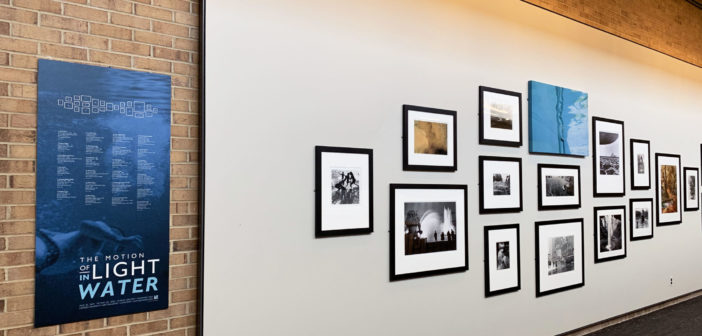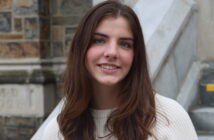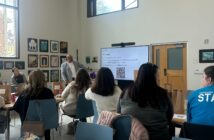In an effort to inspire and educate, Lehigh University Art Galleries, which is housed in Zoellner Arts Center, has created three new exhibits that are featured high-traffic areas of campus.
The three exhibits, “The Motion of Light in Water,” “Brit Pop Snapshot” and “British Abstraction: Three Views” are now on display at Maginnes Hall, Rauch Business Center and Fairchild-Martindale Library, respectively.
“In a large university like Lehigh, we’re always trying to create alignments between things that are happening in the art galleries and things that are happening elsewhere on campus,” said Mark Wonsidler, the curator of exhibitions and collections for the Lehigh University Art Galleries.
Students can align their day-to-day life with the art through different levels of interactions, said Jeff Ludwig-Dicus, the exhibitions’ head preparator. He believes how these three exhibitions affect your day is just as important as how they inspire any kind of research.
“The Motion of Light in Water” is located in Dubois Gallery, Maginnes Hall, until Dec. 6, 2019.
The exhibit, which serves the idea that water can take an array of shapes and shift from one state to another, uses photographs from the Lehigh University Art Galleries’ permanent collection to highlight water as the center of interest in photography.
In particular, the young individual depicted in Peter Turnley’s “Malecón” jumps through a body of water, making it splatter across the colors of the sunset. Through Turnley’s lens, the water is shown to be sweeping and amorphous.
“Water can take on different meanings,” said Stephanie Veto, a professor of photojournalism and videography. “This particular photo is about the action with water. It’s refreshing. It’s cooling. It’s fun. The action gives you a sense of how it’s so hot out there.”
Spanning three floors, the exhibition has many black and white photographs, each capturing the transformative nature of water differently.
An individual photograph can be in razor-sharp focus, with every droplet glassy and keen. Or it can be in a motion blur, blasting through a building on fire.
“Brit Pop Snapshot” is located in the gallery at Rauch Business Center until Dec. 7, 2019.
Across from Rauch’s floor-to-ceiling windows stands a display of colors. Up close, the vibrancy shapes up to be references to Hollywood movies, comic books and pop music.
“Brit Pop Snapshot” unites the works of Eduardo Paolozzi, Patrick Hughes and Patrick Caulfield— British Pop artists who interpreted Americana with a sense of irony and distance.
Paolozzi’s collages trace back to now-retro ephemera. Rendered in red and yellow, a portrait of Elizabeth Taylor sits atop a grid of sinister cartoons. Likewise, the pop art pioneer jumbles images that are engraved in American celebrity and consumer culture.
Caulfield simplified domestic life to figures and lines, while Hughes explores the juxtaposition between household objects and his signature rainbow.
Wonsidler said the exhibition documents a distinct group of artists who were formed by the 1950s, but it was never meant to be encyclopedic.
“It’s a jumping-off point,” he said. “We try to carve out space for a few ideas, but we don’t want to tell people what to think.”
Wonsidler hopes students will take the time to be present with the art they’re seeing. They don’t have to like everything, he said, but it’s important to slow down, pay attention and form their own opinions.
“British Abstraction: Three Views” is located in the study gallery at Fairchild-Martindale Library until May 5, 2020.
“British Abstraction: Three Views” focuses on another crop of British artists from the same period— the abstractionists.
Wonsidler’s said having the two exhibits available simultaneously paints a more complete picture of the time.
“Art history isn’t just a single continuum,” Wonsidler said. “There are always contrasting ideas that overlap in any given moment. The way that story is told is very important.”
On view, Terry Frost, Patrick Heron and William Scott are abstract artists whose works embrace the relationship between geometry and landscape. The connecting thread was inspiration drawn from the fishing town of St. Ives, Cornwall, UK, with its coastal terrain and sun-drenched beaches. These elements are reduced to circles, squares and two-dimensional forms.
“FML is intended to be background,” Ludwig-Dicus said. “In order to gain attention in a space that has a lot of students, the show needs to have an impact. And color is one way to do that.”
The exhibition is scattered in three locations on two floors. Ludwig-Dicus worked on the installation and said the idea was to group the body of work based on similarity in patterns so that there is a touch of each artist in each of the spaces. The setup maintains the interconnected relationship between the three points of view.






Comment policy
Comments posted to The Brown and White website are reviewed by a moderator before being approved. Incendiary speech or harassing language, including comments targeted at individuals, may be deemed unacceptable and not published. Spam and other soliciting will also be declined.
The Brown and White also reserves the right to not publish entirely anonymous comments.